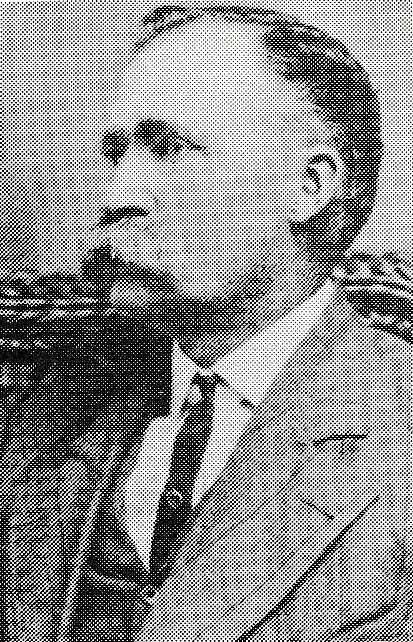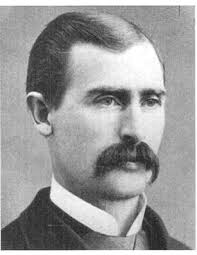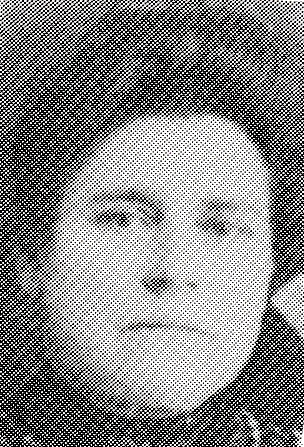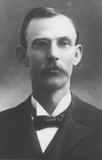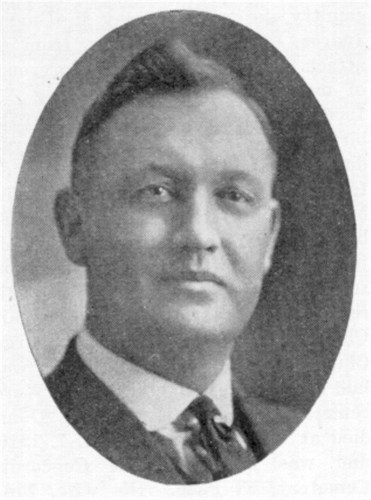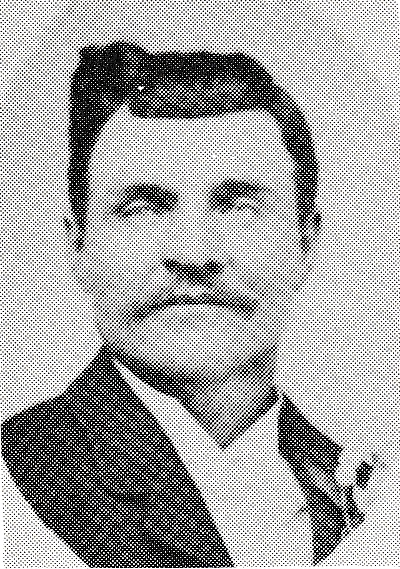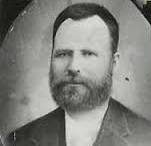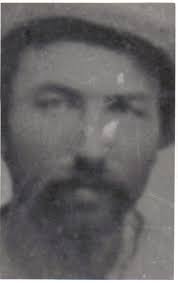David Alma Stevens
1849-1947
David Alma Stevens, son of Walter Stevens and Abigail Elizabeth Holman, was born February 10, 1859, in Holden, Millard County, Utah, formerly known as Buttermilk Fort. He was the first male child born in the Fort. As the son of a frontier family he learned the hardships of pioneering early in life.
In 1879, at the age of 20 he and his brother, Joshua, with a large company of settlers, were called to go to Bluff, San Juan County, Utah. These settlers were told to take all of their belongings as they were to remain there and colonize that part of the country. David, being young and unmarried, was given the task of scouting, herding the cattle and other odd jobs. This party was what has come to be known as the “Hole-in-the-Rock” expedition.
The task assigned the pioneers proved to be more difficult than anticipated. They spent the whole winter making the trip to the Colorado River and on to Bluff. Once at their destination, they discovered that it was much too small to support the entire company assigned to the mission, so those who arrived late were obliged to find other places to settle in that area.
David and Joshua and some of the other settlers liked the country on the La Plata River in New Mexico, which was then being settled. They obtained land from one of the squatters and started on the new project. Corn and wheat were planted and, the land being very fertile, it produced a heavy crop. After the crop was harvested they went back to Holden with the good news. A few of the men were interested in returning with them, including Alma’s father, Walter, and two sons-in-law, Charles Bigler and John Allen. In the fall of 1881, David met Agnes S. Johnson and after a short courtship married her on November 10, 1881. Their honeymoon was a trip to New Mexico in a covered wagon. They stopped in Fruitland where Walter and Abigail made their permanent home. Thus, Fruitland, New Mexico, became the headquarters of the Stevens settlers.
David was an able and fearless man, but Agnes was cautions and fearful. She had not been raised among a lawless element as had David and therefore was rather fearful of such a wild life. She was the daughter of Benjamin F. Johnson who was closely associated with the leaders of the Church. He was called to settle in Santaquin as the Bishop of the Ward there. She had also worked in Salt Lake City and was acquainted with rural life. She did not know how to face the hardships that people had to face in the early days of New Mexico. As long as David was home she was at ease but conditions required him to be away much of the time, with the result that she lived in constant fear.
One of the most dramatic events of the New Mexico range wars involved Mormon settlers in the region, and the Stevens family in particular. It is best described by an observer of the episode, who reported “the La Plata affair” in the Deseret News for December 22, 1886:
In August 1883, Walter Stevens and his eldest son, W.J. Stevens, formerly of Holden, Utah, bought out the claim of one Golden, on the La Plata, each holding half, until the spring of 1886, the son then buying his father out. Prior to the purchase by the son, the father had rented his portion to Hanson Walker, formerly of Pleasant Grove, Utah. In the purchase, young Stevens was to attend to the agreement the father made with Walker for the current year.
In August 1886, Chas. E. Bigler made Stevens an offer for the farm, which he accepted in October, 1886; but, instead of doing this, he left early Monday morning. At noon Bigler arrived with a load of furniture. To his surprise, he found that Walker had gone, and one Dennis Hilton had taken possession having laid some poles belonging to the ranch in a square in front of the house with a notice thereon, also one on the door of the dwelling, and another on the granary, stating that he (Dennis Hilton) had located the ranch this day, (Nov. 8, 1886) etc. Dennis, having left the place in charge of his brother Sherman Hilton, came to this place (Farmington), to procure help, guns and ammunition to assist him carrying out the break he had made. This party thought that, as J. W. Stevens was 85 miles away, running a thresher, and his brother Alma was some 50 miles away, they would have only Bigler to contend against; but to their surprise, the Stevens brothers were only five miles from the farm, and hearing what had taken place hurried on. They arrived at Alma’s place, which joins Bigler’s on the south, about 7:00 p.m., took supper, and then went over to Bigler’s some 80 rods distance. In front of the house was a campfire, and bit it stood Bigler and Hilton. W. J. Stevens said, “Good evening, Boss,” to Dennis Hilton, “You’ve made quite a raise.”
“Yes,” said Dennis.
“How do you expect to make a break like this stick?” inquired Stevens.
“I’ll show you how I’ll make this stick,” said Dennis.
“I want none of your slang,” said Stevens. “I came to see what reason you could offer for jumping this farm.”
“I’ll show you my reason, by G-d,” replied Dennis.
“I want you to understand I’ll not take any of your slang,” said Stevens.
“Well,” said Hilton, “You’re holding land under false pretenses.”
Stevens then proved this to be false by three witnesses present, and that he had sold the place to Bigler. Hilton continued to abuse, and to sue rough language, which was more than Stevens could bear; so he pushed Hilton over and held him down for the space of five minutes, urging him all the while to produce some reason for the step he had taken, which he finally did, then Stevens let him up.
Prior to this, Sherman Hilton and others went to supper a distance of three quarters of a mile, and soon Lon Hilton and Nels Duluche returned from supper. Shortly after two other ruffians came from above, John Duluche and Sam Bowen, Lon Hilton rode back to Sherman’s place; and in the meanwhile S. Duluche and Dennis Hilton retired from the fire in the same direction. Presently the four, Sherman, Dennis, Lon Hilton and John Duluche hove in sight from the way of the stacks, and marked up to the fire with guns and pistols in hand. Here they were joined by S. Bowen. Dennis pointing at J. W. Stevens with his rife said, “That’s the man who choked me.”
Sherman said, “Who?”
Dennis, pointing as before, said, “That one.”
Sherman said, “You D—d son of a gun,” to J. W. Stevens, at the same time firing at him. This being the signal for the Hilton party, the firing became general and lasted about a minute; there being about 30 shots fired at close range.
There were five of the Hilton party who did the shooting, while only two Stevens (brothers) shot on the other side.
Sherman Hilton was mortally wounded and died the following Thursday.
John Duluche was killed on the spot. Alma Stevens received three flesh wounds, one ball passing through the left wrist, between the radius and the ulna, one passing through the fleshy part of his forearm and coming out just below the elbow joint, the third lodging in his right thigh just below the groin. W.J. Stevens, being in the heaviest of the fight, received only powder burns in his face and wrist; he was the last man to leave the battleground. The next morning the Hilton party withdrew from the place.
These Hiltons went before the justice of another precinct, and procured warrants for the arrest of the Stevens boys charging them with murder; also four others who had no part in the fight. There not being enough evidence brought to convict, or bind them over, they were discharged on the grounds of justification.
Last December Sherman Hilton succeeded in jumping the ranch of John Allen, joining David Alma Stevens. He afterwards succeeded in getting his mother-in-law to jump a claim joining Allen’s which had previously taken up by Chas. E. Bigler, who had a house upon it. Sherman Hilton, during last summer, drew his gun two different times on Chas. E. Bigler, without provocation.
The sympathy among all honorable men of this section runs high in favor of the Stevens brothers.
David Alma Stevens was so seriously injured he nearly died. With careful nursing, however, he began to recuperate. When it was reasonably safe for him to travel, he was advised to go to Bluff, Utah, with his family to a ranch up in the mountains where he could recuperate in the cool fresh air. It would also be safer for him inasmuch as it appeared the Hiltons were determined to hunt him down and kill him. During the summer while he was working on the ranch he received a call from the First Presidency to go to Mexico and help colonize that part of the world.
David Alma’s father-in-law, Benjamin F. Johnson, had previously moved his family to the Salt River Valley of Arizona and David Alma asked permission to stay in Mesa for a year to work as he was very short of funds. Such a delay would also allow Agnes, yet shaken from the La Plata fracas, to visit with her folks before going into another country which to her seemed clear out of this world. The request was granted. While he was engaged in that endeavor he took work plowing a section of land for a Mr. Zullik and did very well. While working on an old thresher the team engine blew up and nearly lost both eyes in the explosion which left them both badly burned. He nearly lost his life, also, and carried scars from that explosion to his grave. A cousin, Frank Openshaw, lost both eyes in the same explosion.
Finally, they made the move to Mexico in 1890, locating their home in Colonia Dublan. David Alma and Joshua were in charge of taking care of the colonists’ tithing cattle. As feed began to run out in the lower valleys it became advisable to look for better grazing grounds in the mountains where some of the colonists were settling. David Alma and Joshua decided that Hop Valley would be as good a place as any to take the cattle and the Stevens family went there to live for a season. While there they learned that the Indians had raided and killed the Thompsons who were living on the Pratt ranch not far away.
At this particular time David Alma Stevens was away purchasing supplies in Dublan. The following day when he returned Agnes met him in the yard before he had even gotten off the wagon and told him. He immediately unloaded the cargo he had bought, loaded a few items onto the wagon and left with his family, travelling all that night for safety.
They moved to Colonia Juarez. David Alma spent much time away from home hauling freight from Gallegos to the store, and lumber from the sawmills in the mountains. Other jobs that required time away were railroad construction in the northwestern part of Chihuahua and supervising teams working at other jobs such as hauling ties to the men laying the track.
In 1896 he married Mary Elmira Boice and shortly after that contracted with a Mr. G. W. Webb to do some work on the railroad. Mary went with him to do the cooking for the gang. While they were gone that summer Agnes and the children raised potatoes, milked the range cattle and made butter which was sold and the money used to purchase a baby buggy for baby Irven.
About 1900 a lot of work developed in Sonora out of Naco and Cananea where the William C. Green Company was promoting mining projects. David Alma took his outfit to Sonora and worked there for years. He then returned to the colonies, purchased some land and tried to make a living for his family by farming and doing odd jobs such as hauling lumber and freight. He purchased about a hundred head of cattle from Ernest L. Taylor.
It seemed, however, with all those efforts he was not making enough to take care of his obligations. Therefore, in the early summer of 1905, he decided to try railroading again and took a job on the Kansas City, Mexico and Oriente Railroad with G. W. Webb who was the main contractor. This job took him up into the mountains 77 kilometers south of Minaca. Because of the rain weather he lost a great deal of time. Much of his work consisted of hauling supplies from the main comercio some 30 kilometers distant. In the mud and washed-out roads, only small loads could be hauled at a time. The poor horses suffered from dew poisoning with every scratch or flesh wound.
In December, David Alma Stevens quit that job and moved to another located on the Yaqui River in Sonora with the Southern Pacific Railroad Company. All went well through the winter but when summer came the weather was so hot he could work only part of the day, from 4:00 am to 10:00 am and from 3:00 pm until dark. The job lasted until October.
He then returned to Casas Grandes. He went right to work on the place as soon as the family was settled and planted a good crop of wheat on the land. The method of harvesting in Mexico at the time was to cut with a sickle and then thresh by means of treading with horses. That method seeming too slow, Stevens purchased a header and thresher and hired Fenley Merrill from Dublan to operate it. The first day that the new equipment was put into operation was a spectacular event for the Mexican farmers in the area. They gathered around the field to watch. One prominent Mexican farmer in the crowd, Don Pablo Federico, exclaimed, “This maquina is not of this world!” The Stevenses did very well with their header and thresher by doing jobs for farmers in all parts of the area at harvest time. After they purchased another header and thresher and continued to do well.
David Alma’s tow older sons, Earl and David, had married by 1914. With the younger boys wanting to go to school, Alma sold out to Earl in 1918 and moved to Chandler, Arizona, where he purchased a farm for raising long-staple cotton. Soon after he started and had a good crop, the market for cotton dropped to four cents a pound. Alma then moved Mary with her two small children to Los Angeles, California. He put the children in school and sought work with his teams wherever he could find it in the Los Angeles area. There was much construction work to be done in the area but soon mechanized machinery and heavy equipment took over the work previously done by horsepower.
David found himself out of work. After helping his son, who had a cotton gin in Porvenir, for about two years, he made his last move back to Holden, Millard County, Utah. There he married his cousin, Laura Stevens, on June 18, 1930. Laura was the youngest daughter of David Riley Stevens, brother of his father, Walter Stevens. Laura inherited the family home when her father died so that Alma in his old age had a nice home to live in. He planted two acres of berries and fruit trees, built a chicken coop, and tended a nice flock of chickens.
He passed away in Holden on June 14, 1947, at the age of 88. He was buried at the place of his birth.
David Stevens, son
Stalwarts South of the Border, Nelle Spilsbury Hatch, page 633
More on David Alma Stevens and the “La Plata affair”

